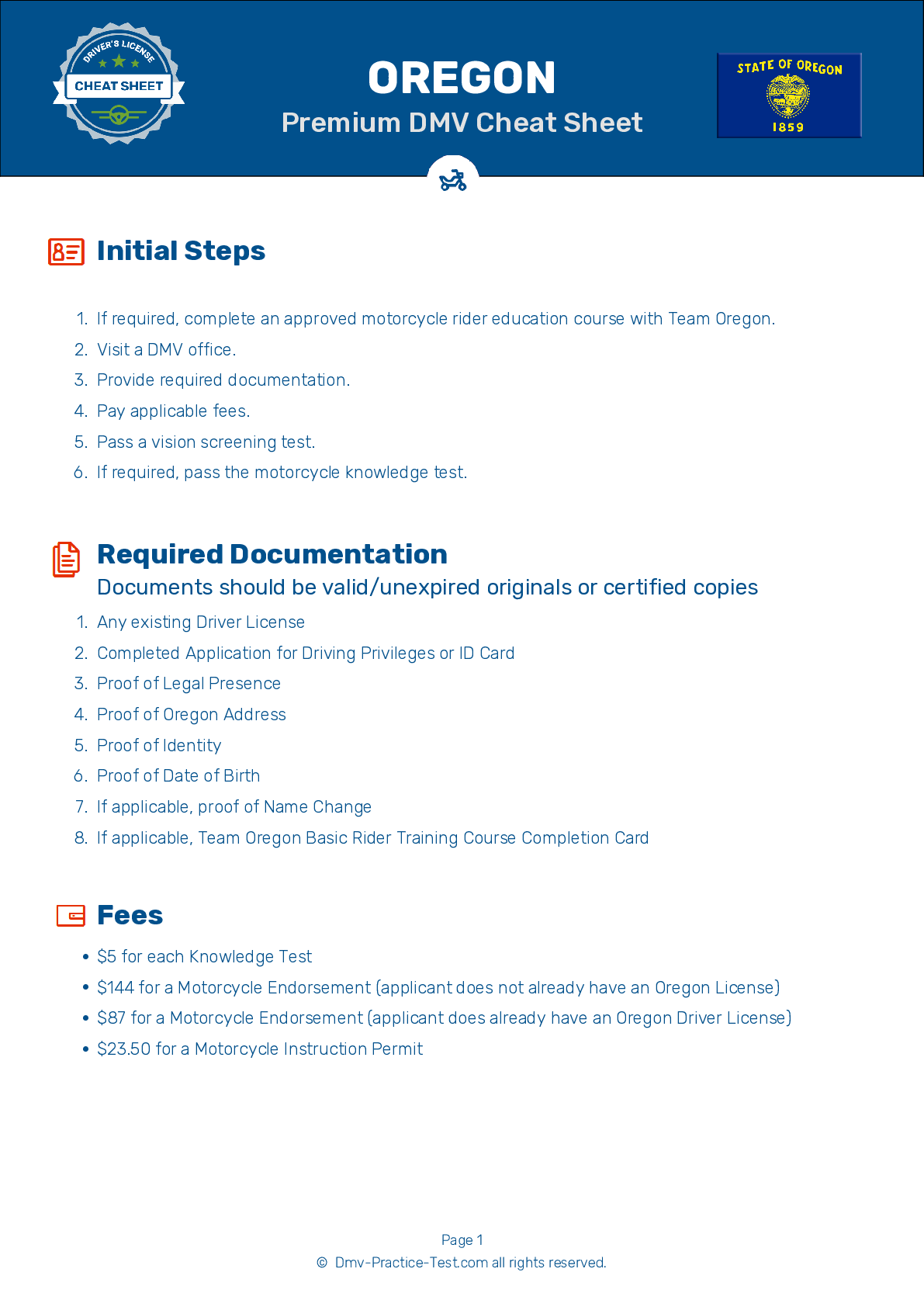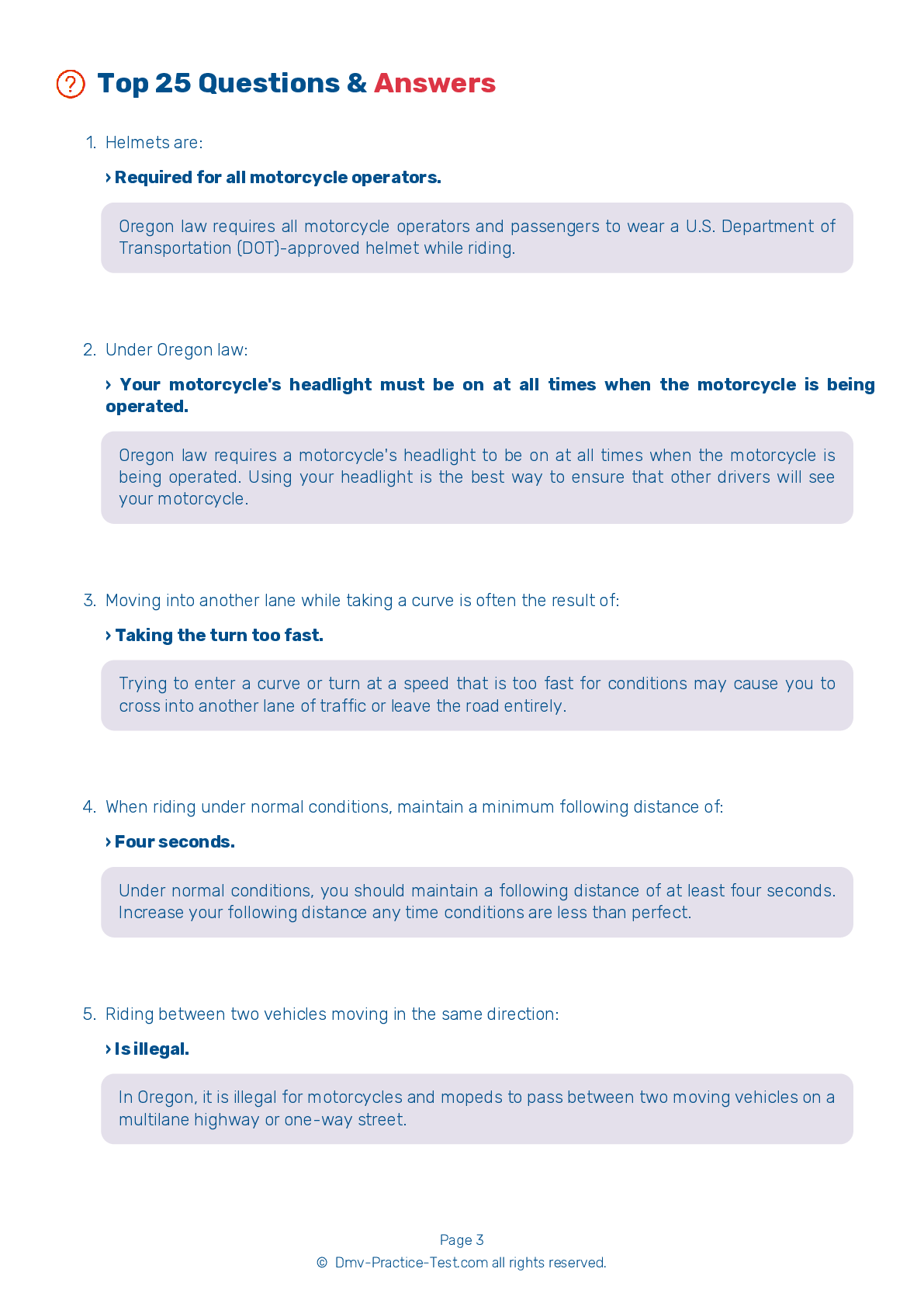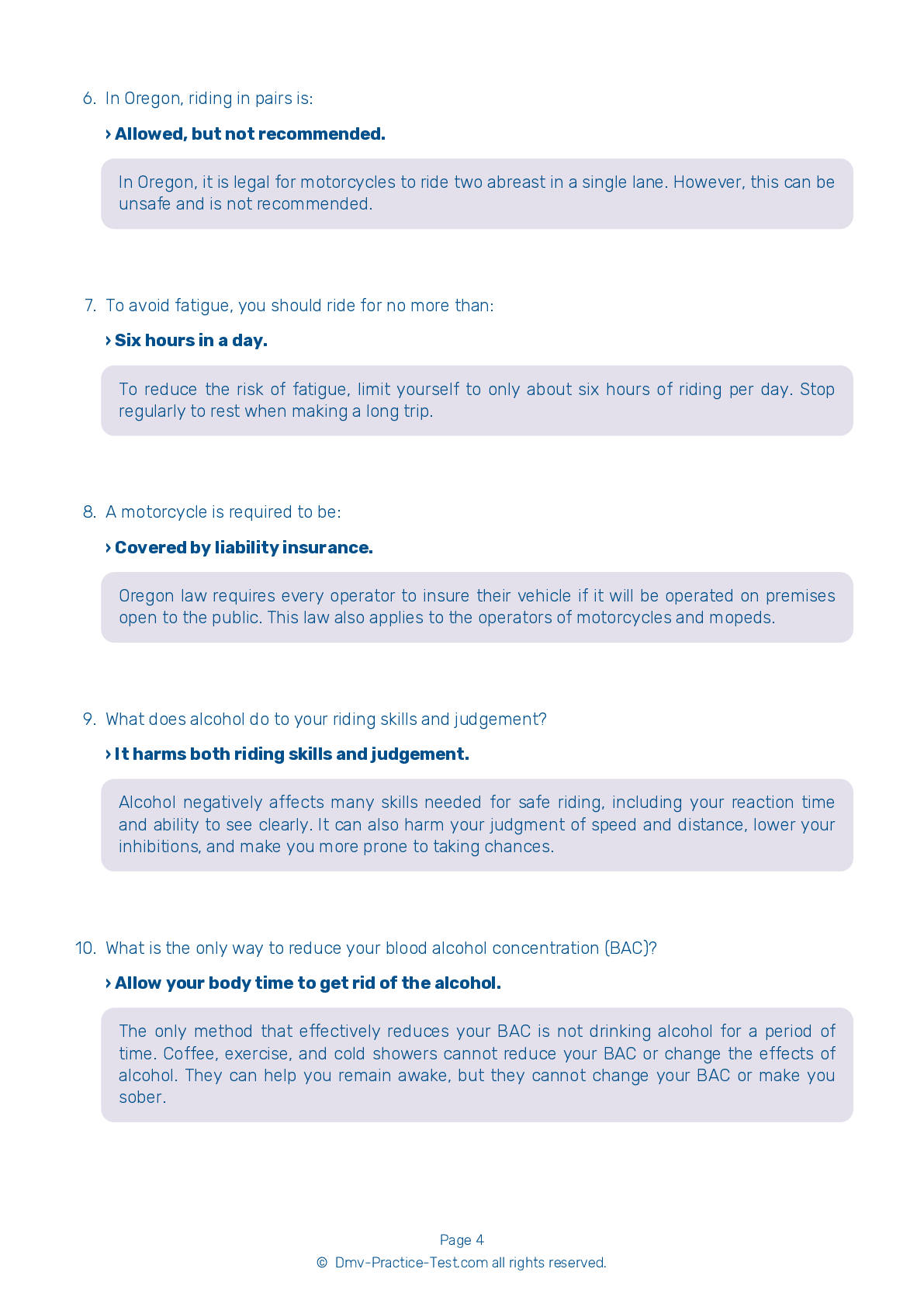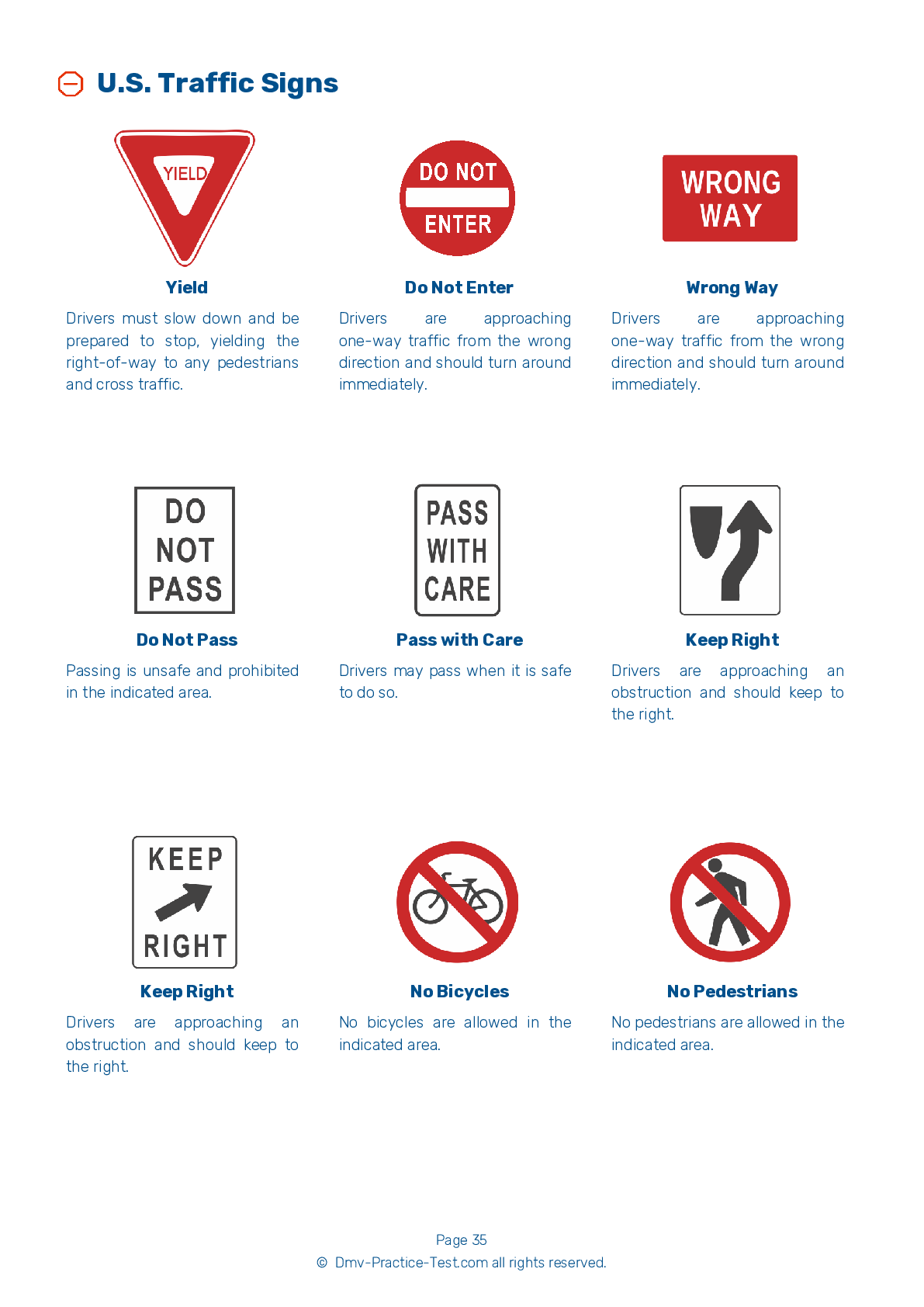DMV Permit Test #1
Motorcycle Test | License OR 2026 | FREE Online Practice! #1 Page 4 of 4
Take this FREE motorcycle test (license in OR 2026) to check your knowledge of the road rules. To improve your results, download a motorcycle handbook online, study theory, and practice for free on our website. Still worried about how to get a motorcycle license in Oregon in 2026? Check our website for more sample tests, train as much as possible, and boost your grades!
25
20
16
19 . To lessen your chances of being involved in a crash, you should:
Not use a headlight during the day.
To lessen the chances of a crash occurring, you should make yourself visible, communicate your intentions to others, maintain adequate space cushions, search your path of travel at least 12 seconds ahead, identify and separate hazards, and be prepared to react to changing conditions.
20 . When it is obvious that you are going to turn, you:
Only need to use a turn signal if you are at a stop light.
You must use proper turn signals every time you turn or change lanes, even if you think your intentions are obvious. Signals are always important, even if no one else seems to be around to see them. There may be other vehicles nearby that you can't see or haven't yet noticed.
21 . When does an Anti-Lock Braking System (ABS) begin operating?
When pressure is released from both the front and rear brakes.
Some motorcycles are equipped with an Anti-Lock Braking System (ABS). ABS is designed to prevent skidding and wheel lock-up when motorcyclists are stopping in straight-line, panic situations. ABS operates when maximum pressure is applied to both the front and rear brake controls. If electronic sensors detect the possibility of a wheel lock, brake hydraulic pressure is released then re-applied to maintain maximum braking effectiveness.
22 . If in a no passing zone:
A motorcycle may pass on the shoulder.
Passing is prohibited in no passing zones. It is also prohibited to pass by riding off of the main-traveled portion of a roadway.
23 . The first thing you should do if your throttle becomes stuck is:
Weave back and forth in your lane.
If your throttle becomes stuck, try twisting it back and forth several times. If this does not free your throttle, immediately operate the engine cut-off switch and pull in the clutch at the same time.
24 . You may carry a passenger:
Under no circumstances.
A motorcycle operator cannot carry a passenger unless the motorcycle is equipped with a permanent passenger seat and footrests.
25 . A motorcycle needs:
To be serviced only at a dealer.
Because a small technical fault can have more serious consequences on a motorcycle than on a car, motorcycles need to be checked more frequently. Complete a thorough check before every ride.
Search the best driving school in your neighbourhood
2026 Oregon | Frequently Asked Questions
To acquire a motorcycle license in Oregon, you must first obtain a motorcycle instruction permit. This involves passing a knowledge test. After practicing with the permit, you can take the motorcycle skills test to get your license. Alternatively, you can complete a Team Oregon Basic Rider Training course which waives the DMV knowledge and skills tests.
In Oregon, the minimum age to obtain a motorcycle endorsement or license is 16. However, individuals under 18 must complete an Oregon Department of Transportation-approved motorcycle rider education course. They must also have had their driver's license for at least six months before they can apply for a motorcycle endorsement.
Yes, in Oregon, you need a dedicated motorcycle endorsement to legally ride a motorcycle. You can add this endorsement to your regular driver's license after passing a written exam and a skills test. Alternatively, you can complete a Team Oregon Basic (or Intermediate) Rider Training course which waives the need for these tests at DMV.
To apply for a motorcycle license in Oregon, you'll need the following documents: proof of identity (like a birth certificate or passport), proof of Social Security number, proof of Oregon residency, and proof of legal presence in the U.S. If you're under 18, you'll also need a parent or guardian's signature on the application form.
Yes, in Oregon, you must pass a written exam to get a motorcycle license. The test covers topics such as traffic laws, safety rules, and identifying road signs. This is to ensure that you understand the rules of the road and can operate a motorcycle safely. However, completion of an approved motorcycle rider education course can waive this requirement.
The Oregon motorcycle written test covers a variety of topics related to motorcycle operation and safety. These include understanding road signs and signals, rules of the road, safe riding techniques, how to handle hazardous conditions, and motorcycle-specific laws. The test is designed to assess your knowledge of safe and responsible motorcycle riding.
Yes, in Oregon, you can substitute the written and skills tests with an approved motorcycle rider education course. Upon successful completion of the course, you'll receive a completion card that you can submit to the DMV within 12 months to waive these tests. This option is available for both new and experienced riders.
To enroll in a motorcycle training course in Oregon, visit the Team Oregon website and choose a course suitable for your skill level. You'll need to pay a fee which varies by course. After payment, you'll receive a confirmation email with details about the class location, what to bring, and when to arrive. Be sure to bring the necessary gear and identification.
No, you don't have to own a motorcycle to take the license test in Oregon. You can use any street-legal, registered, and insured motorcycle for the test. However, make sure that the motorcycle you use is appropriate for the class of license you're applying for and always wear the required safety gear.
Yes, you can use a friend's motorcycle for the Oregon DMV motorcycle skills test, provided it is street-legal, registered, and insured. The motorcycle should also match the class of motorcycle license you are applying for. Remember to wear appropriate safety gear during the test.
Yes, during the Oregon motorcycle driving exam, specific handling skills are tested. These include left and right turns, sudden stops, swerving, and obstacle avoidance. The test also assesses your ability to balance the motorcycle at slow speeds, proper use of mirrors and signals, and adherence to traffic rules. Mastery of these skills is crucial for safe motorcycle operation.
Yes, in Oregon, new motorcycle drivers under the age of 21 are required to complete an approved Team Oregon Basic Rider Training course before they can get their motorcycle endorsement. Also, for the first year after getting the endorsement, they are not allowed to carry passengers or ride between sunset and sunrise.
Yes, your Oregon driver's license with a motorcycle endorsement is valid across the United States. However, it's essential to understand that you must comply with each state's specific motorcycle laws when traveling, such as helmet requirements or lane splitting regulations. Always research local regulations before you ride out of state.
Yes, in Oregon, it's mandatory for all motorcycle riders and passengers to wear approved motorcycle helmets. This law is in place to protect riders from serious injury or death in the event of a crash. The helmet must meet Department of Transportation standards to be considered approved.
Yes, in Oregon you can apply for different types of motorcycle licenses. You can get a motorcycle endorsement (Class M) added to your regular driver's license, or you can get a motorcycle-only license (Class M) if you don't have a regular license. There's also a restricted Class M license for motorcyclists under 21 years old. Each type requires a different process and testing.
Yes, you can add supplementary endorsements to your motorcycle license in Oregon. This could include a sidecar/trike endorsement if you intend to operate a three-wheel motorcycle. To add an endorsement, you'll need to pass both a knowledge test and a skills test specific to the type of endorsement.
Yes, the Oregon DMV offers the motorcycle license test in several languages other than English. These include Spanish, Russian, Vietnamese, Japanese, Korean, and Chinese. If you need the test in a language not listed here, it's best to contact the Oregon DMV directly to inquire about available options.
An effective strategy to prepare for the motorcycle license test is to study the Oregon Motorcycle & Moped Manual thoroughly. It covers all the information you need to pass the test. You can also take online practice tests to familiarize yourself with the format and types of questions asked. It's also helpful to review road signs and signals, and understand motorcycle maintenance basics.
Yes, the Oregon DMV offers the motorcycle written exam in several languages other than English. These include but are not limited to Spanish, Russian, Vietnamese, and Chinese. However, it's advisable to contact your local DMV office in advance to confirm the availability of the test in your preferred language.
Yes, if you do not pass the motorcycle written test in Oregon, you are allowed to retake it. There may be a waiting period before you can retake the test and possible additional fees. It is recommended to study the Oregon Motorcycle & Moped Manual thoroughly before attempting again to increase your chances of passing.




